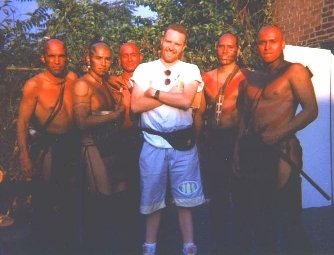
In the summer of 1991, production on the Academy Award-winning film “The Last of the Mohicans” began. Approaching the 30th anniversary of this movie’s origin, let us take a look back at one of the most significant features developed in North Carolina. With gorgeous shooting locations in the mountains of Chimney Rock State Park, the Biltmore Estate in Asheville, and Lake James, this film truly showcases the natural allure of the western part of the state. Adapted from James Fenimore Cooper’s 1826 novel, this motion picture directed by Michael Mann, and starring Daniel-Day Lewis, Madeleine Stowe, Russell Means, and Wes Studi, was a critically-acclaimed feature lauded for its realistic production design, riveting musical score, and stunning cinematography.
As “The Last of the Mohicans” was set in 1757 Upstate New York during the period of the French and Indian War, Michael Mann set out to create a filmmaking environment that would feel as natural and organic as possible. Prior to the days of advanced GPS technology, Mann and his crew scouted locations in the Blue Ridge Mountains by way of helicopter flyovers, surveying potential production settings and pinpointing these positions with instruments reading longitude and latitude degree measurements. One of the primary concerns of Mann was ensuring that the location’s surroundings would be totally isolated from 20th century civilization and technology. This meant carefully avoiding any roads and highways, as well as landmarks with contemporary construction and architecture. After a time of this search process, a secluded region in the mountains of Western North Carolina was settled upon.

Even as many of these shooting locations were technically in North Carolina State Parks, they still maintained an atmosphere of extreme remoteness, unrefined beauty, and primitive charm. I had the privilege of speaking to Noel Manning, Associate Vice President for Communications & Marketing at Gardner-Webb, who served as a Production Assistant for the Assistant Director’s Office on “The Last of the Mohicans” back in 1991. From working as a behind-the-scenes photographer, to directing background extras in various sequences, to collaborating with the special effects crew, Manning was consistently involved in the thick of the action on set. As a North Carolina dweller for the majority of his life, he of course had a rich familiarity of the state, from the beaches of the Eastern coast to the foothills and mountains further west. Even still, Manning found himself truly amazed by the pure serenity to be found in these sections of North Carolina nature. Within the boundaries of the Biltmore Estate itself, Manning describes areas that preserve a feeling of untouched, raw wilderness. His entire experience as a member of the crew deepened his appreciation for the grandeur and brilliance of North Carolina’s landscape. Looking to the construction of Fort William Henry on Lake James, this massive structure was composed entirely of timber from the forests cleared for its development. The production design team had a tremendous respect for not only historical accuracy, but also for the opportunities provided by North Carolina’s ecosystem. Manning was awed by the sheer authenticity on display over the course of the entire production, and he was consistently surprised by the incredible aptitude of the cast and crew to convert 1991 North Carolina into 1757 Upstate New York.

Director Michael Mann possessed such an extraordinary devotion to natural accuracy in regard to shooting locations for the film that the idea of working on a sound stage in a studio backlot was something of a last resort for him. Consider the feature’s iconic scene in the waterfall cave. As our hero and adopted son of the Mohican Tribe, Hawkeye (Daniel Day-Lewis), leads his love, Cora Munro (Madeleine Stowe), away from a group of violent Huron Natives, Hawkeye realizes that there is no escape for the both of them. He makes the difficult decision to leave her behind, as he understands that Magua (Wes Studi), the leader of the Hurons, may yet spare Cora’s life if she gives herself up willingly. Hawkeye, on the other hand, would be killed instantly. Thus, we have the impassioned, desperate monologue from Hawkeye to Cora, just before his dangerous jump through the waterfall: “You stay alive. If they don’t kill you, they’ll take you north up to Huron lands. You submit, do you hear? You’re strong. You survive. You stay alive no matter what occurs. I will find you, no matter how long it takes, no matter how far. I will find you.”
The emotional resonance and honest, genuine humanity represented in this sequence reaches the viewer on a remarkably personal level. Obviously, Mann understood the gravity of this moment, and wanted to uphold the standards of legitimacy he had set throughout the entire production. The process of discovering a satisfactory filming location for this scene was quite complicated. Even though Mann would have preferred otherwise, there was the option of using a sound stage at Earl Owensby Studios in Shelby, North Carolina for this particularly arduous segment of the shoot. The technological resources available at this independent film studio would have made the logistical process much simpler and more efficient. Yet, in his unparalleled filmmaking commitment and in his devout faith to the wilderness, Mann and his team found a cave on the North Carolina/Tennessee border that would sufficiently serve as a production environment. Mann accepted that nothing could possibly compete with the sanctity of the natural world, and it was this decision to led to the ultimate lasting impact of this scene in the film.
If ever there was a film to comprehensively depict the breathtaking majesty of North Carolina, it is most certainly “The Last of the Mohicans.” From the mountains of Chimney Rock, to the peaceful woodlands of the Biltmore Estate in Asheville, your spirit will be stirred and your heart lifted by the promise of North Carolina’s natural splendor.



